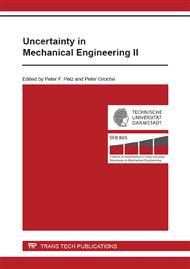p.78
p.89
p.99
p.109
p.121
p.130
p.140
p.153
p.162
Orbital Forming of Flange Parts under Uncertainty
Abstract:
Uncertainty in the properties of semi-finished parts can cause fluctuations in the product properties, especially if they have a strong effect on the process and cannot be compensated by process adjustments. Incremental forming processes have the potential to react to changing conditions by adapting the tool movement during the process. This paper analyzes the feasibility of controlling material flow in an orbital forming process in order to selectively fill those geometric elements which were specified with narrow tolerances by the designer. The effect of different process parameters on the mushroom effect and the degree of mold filling are analyzed by FEM simulations and experiments. In order to realize online monitoring and control, an estimation model is introduced, which maps signals from sensors and the process control to the geometric target values.
Info:
Periodical:
Pages:
121-129
Citation:
Online since:
November 2015
Authors:
Keywords:
Price:
Сopyright:
© 2015 Trans Tech Publications Ltd. All Rights Reserved
Share:
Citation:


